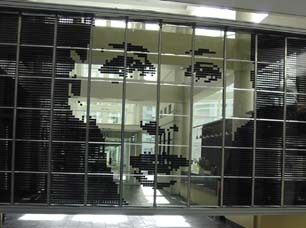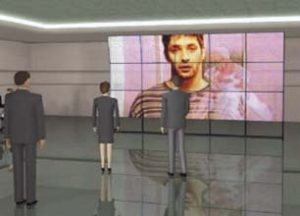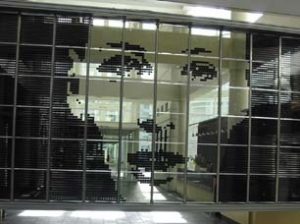Electric Signs
A New Window into the Sign World
Provision’s Transparent Imaging Matrix adds a new dimension to electronic digital signs (EDS).
Published
18 years agoon

Like a Ford Model T, it only comes in basic black and is ordered from only one source. Architects and sign designers who see it, want it. It is the new display process created by Provision Interactive Technologies (Chatsworth, CA). The process, called Transparent Imaging Matrix (T.I.M.), now competes with LEDs, plasma and e-ink display formats in the electronic digital sign (EDS) market. Based on liquid-crystal display (LCD) technology, T.I.M. appeals to architects and sign designers because it offers an unusual twist for large buildings: In its off" position, it appears as a transparent glass sheet. This allows T.I.M. to be a multi-purpose display — a "window" one moment and an advertising display the next moment. Provision, which owns exclusive worldwide distribution rights to the T.I.M. technology, has transformed 15-year-old LCD technology, the same technology commonly used on computer screens and watch displays, to a large-format process that can be incorporated into billboards or standalone signs. Although T.I.M. is offered in color and black and white, the latter has proven to be as spectacular and dramatic as its color counterpart. A wish come true The new display format was born of a client’s wish for a different advertising format."T.I.M. was originally presented to us as a solution looking for a product," recalled Curt Thornton, Provision’s president and CEO. "Several years ago, a customer described a sign display with very specific technical parameters. He wanted a transparent screen that would act as a visual application for outdoor and indoor advertising for shopping malls or public-transit-terminal complexes. He said, ‘Nobody’s doing this. Can you do it?’ We studied the client’s concerns, wrote a specification and transformed it into T.I.M." Bob Ostrander, Provision’s VP of sales and marketing, points to T.I.M.’s potential to break through the "clutter" of existing outdoor advertisements on windows, walls and billboards. "It’s about taking the functionality of signage and advertising out of the box and dressing it up in a new form," he said. "We’ve done this by inventing a new sign format that informs, entertains and communicates messages to consumers at a point-of-purchase location, where people make the final buying decisions." According to Ostrander, T.I.M. can replace static messages located on the front windows of supermarkets, convenience stores and shopping centers. He said, "We define a static message as primarily a vinyl graphic or paper sign that’s manually applied on a store window, usually for 24 hours or longer, blocks views into the store and gets dated quickly because it isn’t replaced in a timely manner." Instead, T.I.M. disappears when required and continually updates advertising messages. Thornton said he thinks of it as "smart glass." The new format’s future applications could include indoor sign displays, video walls, billboards, and outdoor and public art. Over time, as more people become familiar with T.I.M., its use will broaden into myriad applications. How it works T.I.M. is based on 15-year-old LCD technology used in readout displays on digital watches. Liquid crystals are basically an on-off signaling process. When a crystal pixel is charged, it becomes opaque. In a digital watch, the charged liquid crystals form a matrix that creates a numerical dial. T.I.M.’s basic unit, a high-resolution, large-format, electronic tile, comprises an LCD filter film inserted between two, 12 x 10-in. glass sheets. The glass secures the film and protects it from weather and other outdoor conditions. The electronic film, comprising thousands of white, 4mm-pixel cells, connects to an electronic interface, which attaches to an integral mullion that acts like a cable trough for the electrical connection. When the cells are charged, they turn opaque, or black, creating an image on the display. Individual tiles can be removed and easily replaced. To create a complete T.I.M. display, tiles are attached in a single column, which in turn, is connected, via support mullions, to each additional column. All columns are held in a frame, not unlike the shape of a traditional billboard. T.I.M. is like an electronically controlled light valve that doesn’t generate light, unlike LEDs. Rather than washing out T.I.M. images, sunlight increases its brightness and contrast ratios. At night, T.I.M. functions best when artificial lighting illuminates and enhances its display imagery. Thus, T.I.M. image brightness is directly proportionate to surrounding ambient light. As T.I.M. emerges as a standalone electronic-display, there’s a natural tendency to compare its functionality and cost per sq. ft. to LEDs. Ostrander said, "The T.I.M. panels in our black-and-white displays have a pixel range of 4mm, as compared to the smallest, affordable LED range, which is about 8mm and expensive. In both black-and-white and color, T.I.M costs between $2,500 and $3,500 per sq. ft. It’s an equivalent range, but T.I.M. has a higher resolution in black-and-white than its LED counterpart." As for T.I.M.’s electrical consumption, on a per-square-foot comparison, T.I.M. consumes about 10% of the electricity that the same square foot of LEDs would consume, Ostrander claims. T.I.M. displays will accept all digital formats, including NTSC, PAL, Hi-Def video, AVI and MPEG files, and can reportedly stream up to 30 frames a second with no screen light loss or image washout. Images are viewable from both sides of the screen, like a stained-glass window. Text can be rotated or flipped back and forth, allowing viewers on either side of the window to read advertising content. A future TIMline As T.I.M. emerges as a sign-display medium, Thornton said it will follow two paths. "First, it will parallel LED sign systems. Because of T.I.M.’s capability to display computer-graphic animations and video signals, it will act as another type of EDS device, similar to electronic billboards and video walls." Thornton continued, "Our second path will be to install T.I.M. where LED displays can’t be used. We have specialized advantages, such as transparency, light weight [one pound] per sq. ft. of usage, thin format [panels are 3mm thick] and low energy consumption, which are all special features to provide us with a competitive, divergent path from LEDs." T.I.M. has many signage, art and advertising applications, but architects foresee its use in exterior wall cladding. In its natural, "off" state, T.I.M. is a sheet of glass, which is commonly used to build wall curtains. "With T.I.M. added into the mix," Thornton explained, "a building can assume an entirely new identity as a visual, brand extension of what the corporation is all about." Come dusk, when everybody goes home, with a flick of a switch, the glass building becomes a huge promotion for its corporate tenant. Already, Provision’s first major U.S. T.I.M. sale involves a black-and-white, 4 x 8-ft., 4mm panel, placed in Caesar’s Palace in Las Vegas. The display, installed across from the new Celine Dion Theater, will be used as a central feature in Caesar’s Palace’s common court for theater, casino and food-court announcements. Other pending sales include wall advertising and public-display message centers. Most forthcoming projects are in non-disclosure form now, but they show that the architectural community has a developing understanding of T.I.M.’s potential. T.I.M. is now in the "Kitty Hawk" days of its exposure to the professional design community. In most applications, it’s not a replacement for LEDs, and there’s certainly room for both technologies as sign formats. In fact, visionary sign designers may use both technologies in hybrid sign format. Ultimately, T.I.M. can expand the sign-design pallette and help optimize the electronic-display format. It’s clearly a case of the medium being the message, and something that Marshall McLuhan would have seen as a very "cool" technology. Photo credits: Provision Interactive Technologies

SPONSORED VIDEO
Introducing the Sign Industry Podcast
The Sign Industry Podcast is a platform for every sign person out there — from the old-timers who bent neon and hand-lettered boats to those venturing into new technologies — we want to get their stories out for everyone to hear. Come join us and listen to stories, learn tricks or techniques, and get insights of what’s to come. We are the world’s second oldest profession. The folks who started the world’s oldest profession needed a sign.
You may like

Michigan Residents Make Parodies of Viral Detroit City Sign

What Makes the Perfect Sign Business Partnership

Marketing Signs to Schools, Tradeshow and Quote Follow-up Make May’s List
Subscribe

Bulletins
Get the most important news and business ideas from Signs of the Times magazine's news bulletin.
Most Popular
-

 Photo Gallery1 week ago
Photo Gallery1 week ago30 Snapshots of the 2024 ISA Sign Expo
-

 Ask Signs of the Times2 weeks ago
Ask Signs of the Times2 weeks agoWhy Are Signs from Canva so Overloaded and Similar?
-

 Paula Fargo1 week ago
Paula Fargo1 week ago5 Reasons to Sell a Sign Company Plus 6 Options
-

 Real Deal4 days ago
Real Deal4 days agoA Woman Sign Company Owner Confronts a Sexist Wholesaler
-

 Photo Gallery1 week ago
Photo Gallery1 week ago21 Larry Albright Plasma Globes, Crackle Tubes and More
-

 Women in Signs2 weeks ago
Women in Signs2 weeks ago2024 Women in Signs: Brandi Pulliam Blanton
-

 Women in Signs1 week ago
Women in Signs1 week ago2024 Women in Signs: Alicia Brothers
-

 Signs of the Times1 week ago
Signs of the Times1 week agoJuly 1919 Signs of the Times Cover Features Woman Installer













